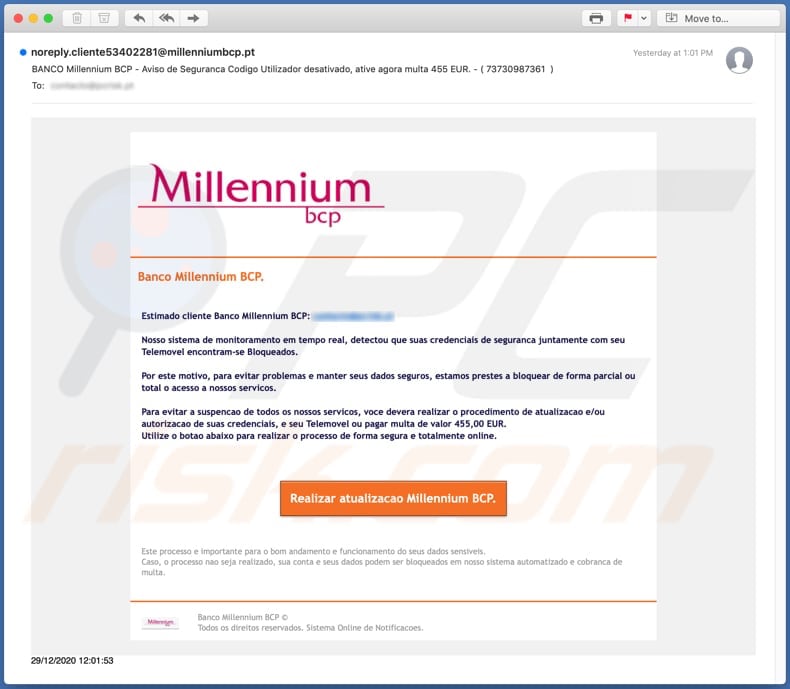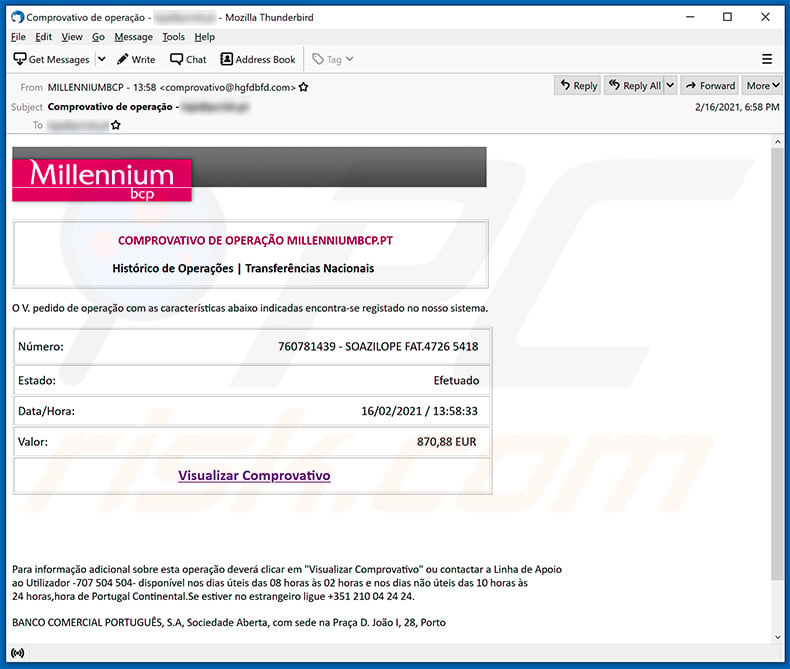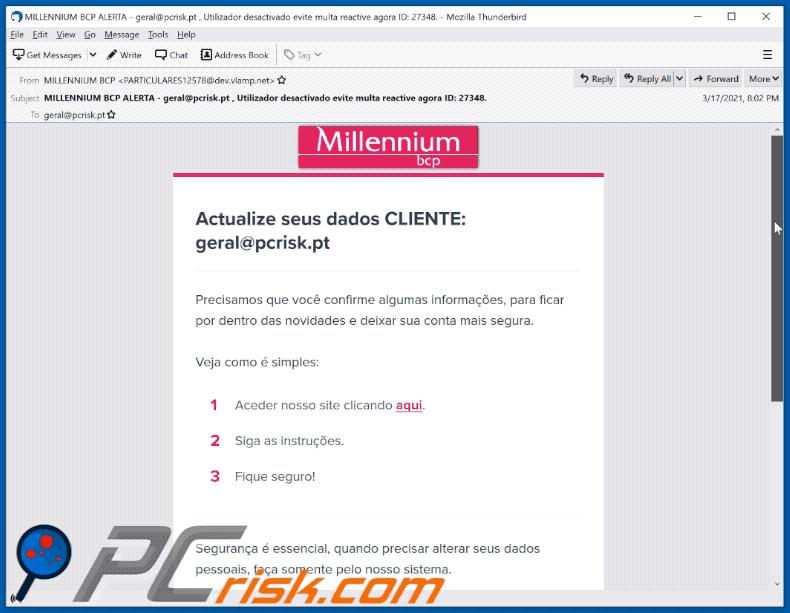Do not open website links in Banco Millennium BCP phishing emails
Phishing/ScamAlso Known As: Banco Millennium BCP spam
Get free scan and check if your device is infected.
Remove it nowTo use full-featured product, you have to purchase a license for Combo Cleaner. Seven days free trial available. Combo Cleaner is owned and operated by RCS LT, the parent company of PCRisk.com.
What is Banco Millennium BCP email scam?
In most cases, scammers/cyber criminals behind phishing emails such as this one attempt to trick recipients into providing their login credentials, credit card details, and other sensitive information. They usually disguise their emails as official, important messages from legitimate companies.
This particular phishing email is disguised as a message from Portuguese Commercial Bank. Therefore, scammers behind it target people who use services of this particular bank.

The main purpose of this phishing email is to trick recipients into believing that their banking accounts are blocked due security reasons, and the only way to recover access to them is to update and/or authorize their banking credentials, or pay a fine of 455 Euros.
Recipients are instructed to update and/or authorize their banking credentials via the provided website link and the "Realizar atualizacao Millennium BCP" button. The genuine Portuguese Commercial Bank (BCP) has nothing to do with this email. The website provided in the message is fake and used to steal banking credentials.
Recipients who provide any details on the bogus web page could lose access to their bank accounts, suffer monetary loss, and experience other issues.
| Name | Banco Millennium BCP Email Scam |
| Threat Type | Phishing, Scam, Social Engineering, Fraud |
| Fake Claim | Recipient's BCP bank account is blocked |
| Disguise | Email from Portuguese Commercial Bank |
| Symptoms | Unauthorized online purchases, changed online account passwords, identity theft, illegal access of the computer. |
| Distribution methods | Deceptive emails, rogue online pop-up ads, search engine poisoning techniques, misspelled domains. |
| Damage | Loss of sensitive private information, monetary loss, identity theft. |
| Malware Removal (Windows) |
To eliminate possible malware infections, scan your computer with legitimate antivirus software. Our security researchers recommend using Combo Cleaner. Download Combo CleanerTo use full-featured product, you have to purchase a license for Combo Cleaner. 7 days free trial available. Combo Cleaner is owned and operated by RCS LT, the parent company of PCRisk.com. |
Other email phishing examples are "Google Forms Email Scam", "Mail - Quarantined Email Scam" and "Banco Montepio Email Scam".
Note that scammers/cyber criminals often use emails to trick recipients, not only into providing sensitive information, but also into making money transactions or even installing malware (e.g., ransomware, Trojan-type malware) onto their computers.
How do spam campaigns infect computers?
Malware (including ransomware) is usually distributed via malspam campaigns, unofficial software activation ('cracking') tools, Trojans, dubious file/software download sources, and fake software updating tools.
When cyber criminals attempt to distribute malware via malspam campaigns, they send emails that contain malicious attachments or download links for malicious files. Typically, they disguise their emails as official and important. If recipients open the attached file (or a file downloaded via a website link), they cause installation of malicious software.
Cyber criminals commonly attach executable files (.exe), archive files such as RAR, ZIP, PDF documents, JavaScript files and Microsoft Office documents to their emails. Software 'cracking' tools supposedly activate licensed software illegally (bypass activation), however, they often install malicious programs and do not activate any legitimate installed software.
Trojans are other rogue programs that can cause chain infections. I.e., when a Trojan is installed on the operating system, it can install additional malware.
Free file hosting websites, freeware download websites, Peer-to-Peer networks (e.g., torrent clients, eMule), unofficial websites, and third party downloaders are examples of other sources that are used to distribute malware. Cyber criminals disguise malicious files as legitimate and regular. When users download and open them, they inadvertently infect their computers with malware.
Fake software updating tools install malicious software rather than updates/fixes for installed programs, or they exploit bugs/flaws of outdated software that is installed on the operating system.
How to avoid installation of malware
You are advised to download files and programs from official websites and via direct download links. Other tools and sources such as third party downloaders and installers, unofficial pages, and Peer-to-Peer networks (e.g., eMule, torrent clients) should not be used to download or install software.
Check all "Custom", "Advanced" and other similar settings (or available checkboxes) for offers to download and/or install unwanted apps. Do not click ads on dubious websites, since they can be designed to open bogus web pages or cause unwanted downloads and installations.
Remove any unwanted, suspicious extensions, plug-ins and add-ons installed on the browser, and software of this kind from the operating system.
If you have already opened malicious attachments, we recommend running a scan with Combo Cleaner Antivirus for Windows to automatically eliminate infiltrated malware.
Text presented in the Banco Millennium BCP phishing email:
Subject: BANCO Millennium BCP - Aviso de Seguranca Codigo Utilizador desativado, ative agora multa 455 EUR. - ( 73730987361 )
Banco Millennium BCP.Estimado cliente Banco Millennium BCP:
Nosso sistema de monitoramento em tempo real, detectou que suas credenciais de seguranca juntamente com seu Telemovel encontram-se Bloqueados.
Por este motivo, para evitar problemas e manter seus dados seguros, estamos prestes a bloquear de forma parcial ou total o acesso a nossos servicos.
Para evitar a suspencao de todos os nossos servicos, voce devera realizar o procedimento de atualizacao e/ou autorizacao de suas credenciais, e seu Telemovel ou pagar multa de valor 455,00 EUR.
Utilize o botao abaixo para realizar o processo de forma segura e totalmente online.Realizar atualizacao Millennium BCP.
Este processo e importante para o bom andamento e funcionamento do seus dados sensiveis.
Caso, o processo nao seja realizado, sua conta e seus dados podem ser bloqueados em nosso sistema automatizado e cobranca de multa.Banco Millennium BCP ©
Todos os direitos reservados. Sistema Online de Notificacoes.
Another example of Banco Millennium BCP spam email:

Text presented within:
Subject: Comprovativo de operação - ********
COMPROVATIVO DE OPERAÇÃO MILLENNIUMBCP.PTHistórico de Operações | Transferências Nacionais
O V. pedido de operação com as características abaixo indicadas encontra-se registado no nosso sistema.
Número: 760781439 - SOAZILOPE FAT.4726 5418
Estado:
Efetuado
Data/Hora: 16/02/2021 / 13:58:33
Valor:870,88 EUR
Visualizar ComprovativoPara informação adicional sobre esta operação deverá clicar em "Visualizar Comprovativo" ou contactar a Linha de Apoio
ao Utilizador -707 504 504- disponível nos dias úteis das 08 horas às 02 horas e nos dias não úteis das 10 horas às
24 horas,hora de Portugal Continental.Se estiver no estrangeiro ligue +351 210 04 24 24.BANCO COMERCIAL PORTUGUÊS, S.A, Sociedade Aberta, com sede na Praça D. João I, 28, Porto
Yet another example of Banco Millennium BCP-themed spam email promoting a phishing website:

Text presented within:
Subject: MILLENNIUM BCP ALERTA - ******** , Utilizador desactivado evite multa reactive agora ID: 27348.
Millennium Logo
Actualize seus dados CLIENTE: ********Precisamos que você confirme algumas informações, para ficar por dentro das novidades e deixar sua conta mais segura.
Veja como é simples:
1 Aceder nosso site clicando aqui.
2 Siga as instruções.
3 Fique seguro!Segurança é essencial, quando precisar alterar seus dados pessoais, faça somente pelo nosso sistema.
Central de Atendimento Millennium
Duvidas? Saiba mais na nossa Central de Ajuda.
SAC
Atendimento 24 horas, todos os diasOuvidoria
Dias úteis das 10h às 12h e 13h às 15h
Facebook do Millennium Twitter do Millennium Instagram do MillenniumO millenniumbcp.pt é um serviço do Banco Comercial Português S.A.
Instant automatic malware removal:
Manual threat removal might be a lengthy and complicated process that requires advanced IT skills. Combo Cleaner is a professional automatic malware removal tool that is recommended to get rid of malware. Download it by clicking the button below:
DOWNLOAD Combo CleanerBy downloading any software listed on this website you agree to our Privacy Policy and Terms of Use. To use full-featured product, you have to purchase a license for Combo Cleaner. 7 days free trial available. Combo Cleaner is owned and operated by RCS LT, the parent company of PCRisk.com.
Quick menu:
- What is Banco Millennium BCP spam?
- Types of malicious emails.
- How to spot a malicious email?
- What to do if you fell for an email scam?
Types of malicious emails:
![]() Phishing Emails
Phishing Emails
Most commonly, cybercriminals use deceptive emails to trick Internet users into giving away their sensitive private information, for example, login information for various online services, email accounts, or online banking information.
Such attacks are called phishing. In a phishing attack, cybercriminals usually send an email message with some popular service logo (for example, Microsoft, DHL, Amazon, Netflix), create urgency (wrong shipping address, expired password, etc.), and place a link which they hope their potential victims will click on.
After clicking the link presented in such email message, victims are redirected to a fake website that looks identical or extremely similar to the original one. Victims are then asked to enter their password, credit card details, or some other information that gets stolen by cybercriminals.
![]() Emails with Malicious Attachments
Emails with Malicious Attachments
Another popular attack vector is email spam with malicious attachments that infect users' computers with malware. Malicious attachments usually carry trojans that are capable of stealing passwords, banking information, and other sensitive information.
In such attacks, cybercriminals' main goal is to trick their potential victims into opening an infected email attachment. To achieve this goal, email messages usually talk about recently received invoices, faxes, or voice messages.
If a potential victim falls for the lure and opens the attachment, their computers get infected, and cybercriminals can collect a lot of sensitive information.
While it's a more complicated method to steal personal information (spam filters and antivirus programs usually detect such attempts), if successful, cybercriminals can get a much wider array of data and can collect information for a long period of time.
![]() Sextortion Emails
Sextortion Emails
This is a type of phishing. In this case, users receive an email claiming that a cybercriminal could access the webcam of the potential victim and has a video recording of one's masturbation.
To get rid of the video, victims are asked to pay a ransom (usually using Bitcoin or another cryptocurrency). Nevertheless, all of these claims are false - users who receive such emails should ignore and delete them.
How to spot a malicious email?
While cyber criminals try to make their lure emails look trustworthy, here are some things that you should look for when trying to spot a phishing email:
- Check the sender's ("from") email address: Hover your mouse over the "from" address and check if it's legitimate. For example, if you received an email from Microsoft, be sure to check if the email address is @microsoft.com and not something suspicious like @m1crosoft.com, @microsfot.com, @account-security-noreply.com, etc.
- Check for generic greetings: If the greeting in the email is "Dear user", "Dear @youremail.com", "Dear valued customer", this should raise suspiciousness. Most commonly, companies call you by your name. Lack of this information could signal a phishing attempt.
- Check the links in the email: Hover your mouse over the link presented in the email, if the link that appears seems suspicious, don't click it. For example, if you received an email from Microsoft and the link in the email shows that it will go to firebasestorage.googleapis.com/v0... you shouldn't trust it. It's best not to click any links in the emails but to visit the company website that sent you the email in the first place.
- Don't blindly trust email attachments: Most commonly, legitimate companies will ask you to log in to their website and to view any documents there; if you received an email with an attachment, it's a good idea to scan it with an antivirus application. Infected email attachments are a common attack vector used by cybercriminals.
To minimise the risk of opening phishing and malicious emails we recommend using Combo Cleaner Antivirus for Windows.
Example of a spam email:

What to do if you fell for an email scam?
- If you clicked on a link in a phishing email and entered your password - be sure to change your password as soon as possible. Usually, cybercriminals collect stolen credentials and then sell them to other groups that use them for malicious purposes. If you change your password in a timely manner, there's a chance that criminals won't have enough time to do any damage.
- If you entered your credit card information - contact your bank as soon as possible and explain the situation. There's a good chance that you will need to cancel your compromised credit card and get a new one.
- If you see any signs of identity theft - you should immediately contact the Federal Trade Commission. This institution will collect information about your situation and create a personal recovery plan.
- If you opened a malicious attachment - your computer is probably infected, you should scan it with a reputable antivirus application. For this purpose, we recommend using Combo Cleaner Antivirus for Windows.
- Help other Internet users - report phishing emails to Anti-Phishing Working Group, FBI’s Internet Crime Complaint Center, National Fraud Information Center and U.S. Department of Justice.
Share:

Tomas Meskauskas
Expert security researcher, professional malware analyst
I am passionate about computer security and technology. I have an experience of over 10 years working in various companies related to computer technical issue solving and Internet security. I have been working as an author and editor for pcrisk.com since 2010. Follow me on Twitter and LinkedIn to stay informed about the latest online security threats.
PCrisk security portal is brought by a company RCS LT.
Joined forces of security researchers help educate computer users about the latest online security threats. More information about the company RCS LT.
Our malware removal guides are free. However, if you want to support us you can send us a donation.
DonatePCrisk security portal is brought by a company RCS LT.
Joined forces of security researchers help educate computer users about the latest online security threats. More information about the company RCS LT.
Our malware removal guides are free. However, if you want to support us you can send us a donation.
Donate
▼ Show Discussion